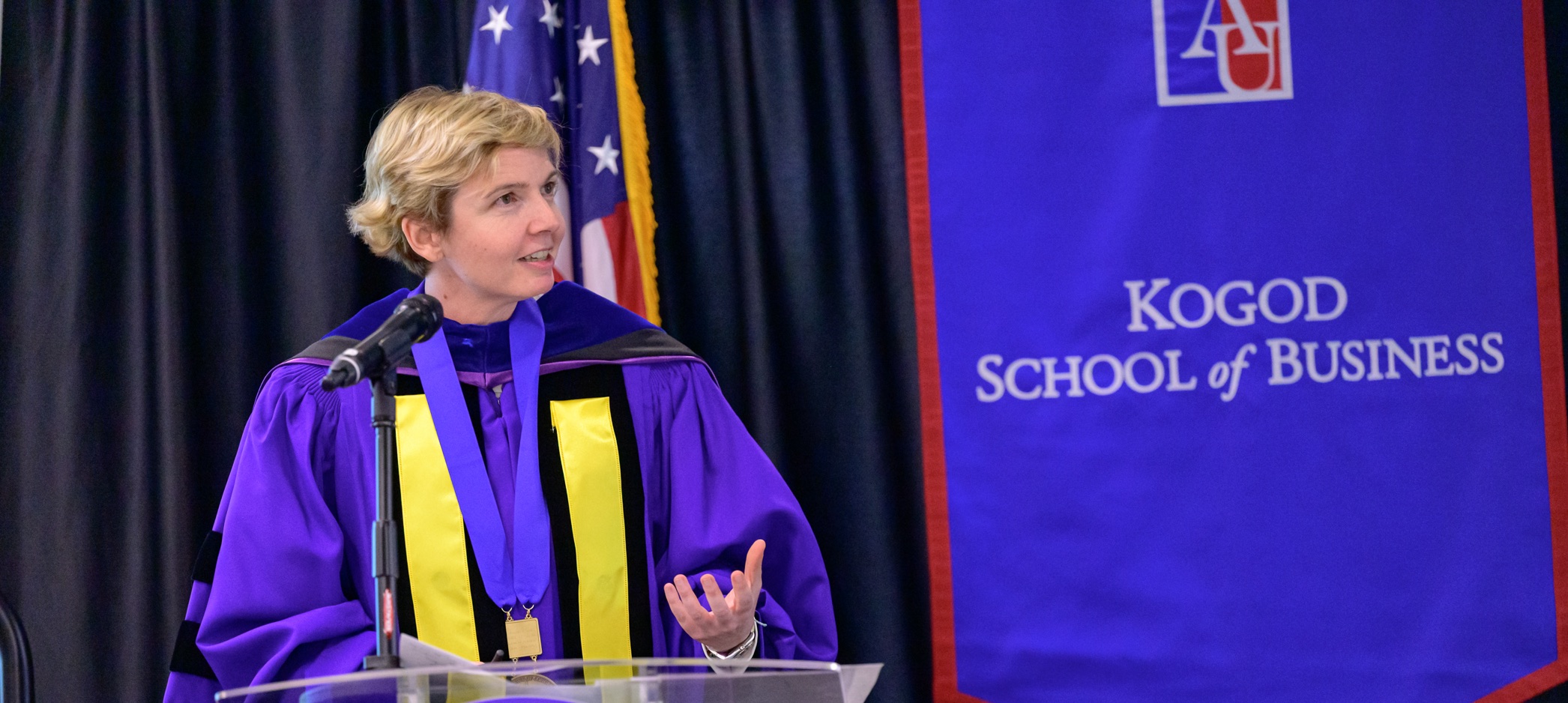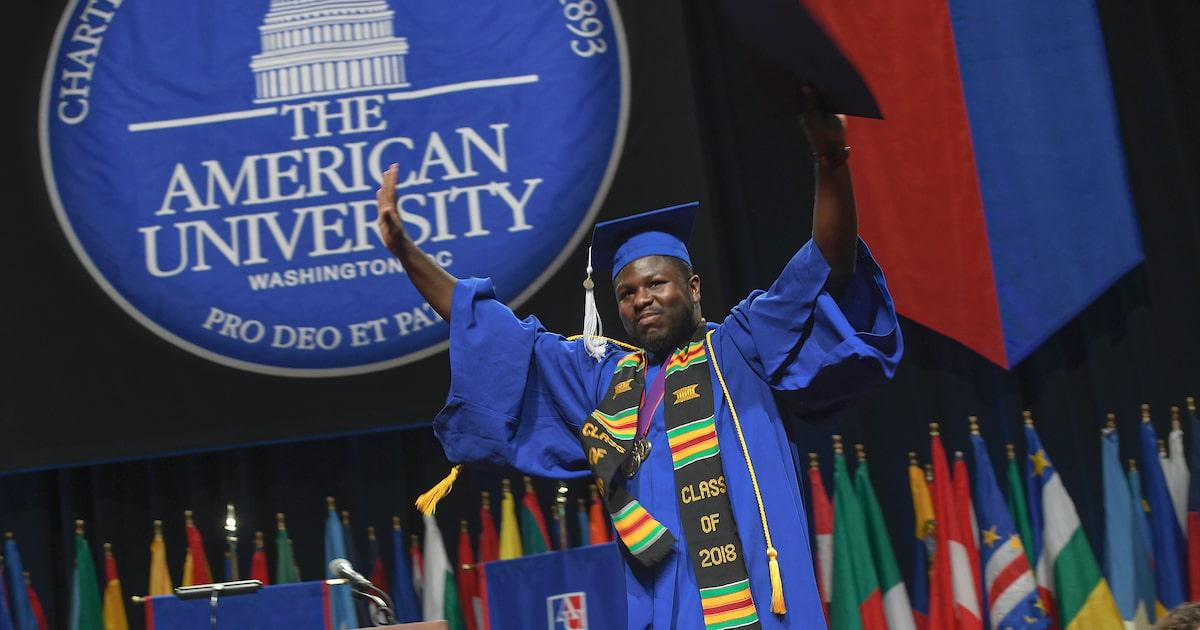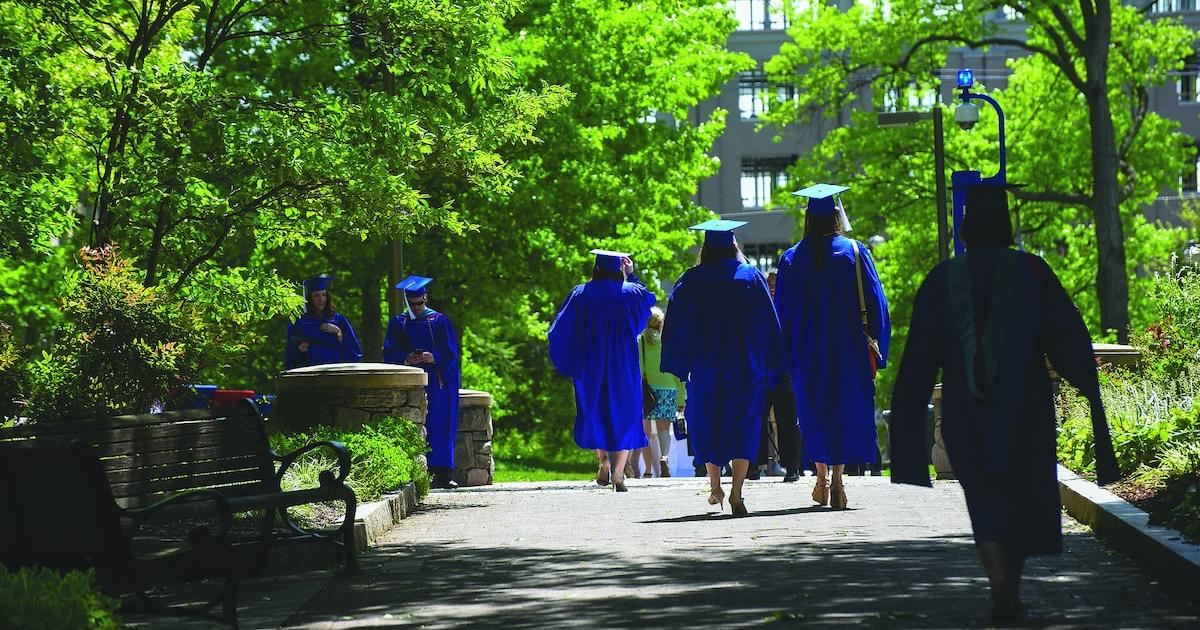
Before an audience of university leadership, colleagues, students, and friends in American University’s Constitution Hall, Professor Valentina Bruno was installed as the inaugural Arlene R. and Robert P. Kogod Eminent Scholar Chair in Finance.
The ceremony on January 26, 2024, marked the second of three faculty chairs endowed at the Kogod School of Business by the Kogod family through a landmark $15 million Change Can’t Wait gift. Bruno’s installation follows the inauguration of Professor Sonya Grier as Kogod Eminent Scholar Chair in Marketing in November. The third chair is pending appointment.
Endowed chairs are among the highest honors in academia bestowed upon faculty. A hallmark of leading higher education institutions, endowed chairs recognize exceptional scholarship and teaching and provide funding to propel further research.
In their remarks to the ceremony’s nearly 150 attendees, members of university leadership emphasized Bruno’s impact as one of today’s top scholars working within the intersection of macroeconomics and finance.
David Marchick, dean of the Kogod School of Business, credited Bruno as a “risk-taker” whose perseverance and scholarship have “broken boundaries” in disrupting once-conventional financial theories about liquidity and currency exchange.
He described her career as one of ambitious leaps, rather than incremental steps—starting with her decision to leave her native Italy and book a one-way ticket to pursue her PhD at the London School of Economics. Later, as she began to propose rethinkings of market behaviors, Bruno faced rejection from the leading journals.
“But then—in classic Valentina fashion—when she broke through, she broke through big,” Marchick said.
Bruno’s work on financial stability and liquidity in the system has produced dramatic ripple effects throughout the field. It has appeared on the cover of The Economist, been cited by the Federal Reserve Chair, and informed a G20 summit.
Equally trailblazing is her work on exchange rates. Looking holistically at the global financial ecosystem, Bruno found that the dominance of the US dollar contradicted a decades-held belief that developing countries should devalue their currency in order to boost exports.
“Valentina’s research flipped that [theory] on its head,” explained Marchick. “Her research proved that strategies to depreciate currency for developing countries don’t work.”
Bruno’s boldness in scholarship was echoed by President Sylvia M. Burwell and Acting Provost and Chief Academic Officer Vicky Wilkins in in their remarks.
“Truly groundbreaking research . . . goes beyond the research community’s prior understanding of an issue and actually serves to shift the prevailing paradigm,” said Wilkins.
As part of the installation ceremony, Bruno was presented with a medal and invited to deliver an inaugural lecture titled “The New Architecture of Finance” as chairholder.
“As a milestone in my career, this event is both a culmination and a beginning,” began Bruno.
In her words, the ceremony was deeply meaningful, especially with her daughter Angie present in the audience, as well as former students who had traveled to DC for the special day.
With characteristic warmth and humor, Bruno reflected first on the unique scholar-teacher role with which AU tasks its faculty. She shared words and memories from students to describe an evolution in her perspective since joining AU in 2007.
“Time made me realize that being a teacher is much more than getting good evaluations—it is about opening the office door and listening to the students, especially in their darkest moments,” said Bruno. “Often it is about reminding students to smile and go with a positive attitude during the job interview, to check that the dress shirt does not have tomato stains on it,” she added, drawing laughter from the audience.
Delving into her lecture, Bruno outlined the interconnected “architecture” comprising the global financial system. Her ongoing work focuses on innovating methods of financial modeling to more accurately account for these connections.
Bruno explained, “The complexity of globalization and the rise of new vulnerabilities in the world economy call for rewriting the economic models in a way that better conforms to the disruption, challenges, and realities of today.”
At the core of Bruno’s research is a key tenet: behaviors of financial markets impact the real economy. What affects a part affects the whole.
To demonstrate this idea, Bruno referenced three architectural analogies—the ill-fated Sutyagin house in Russia, London’s Millennium Bridge, and the Hub of Huts alpine hotel in Italy—in the context of the 2007-2008 Global Financial Crisis (GFC).
Once the tallest wooden house in Russia, Sutyagin’s unregulated height and vulnerability to fire (it ultimately burned down in 2012) evokes for Bruno the excessive leverage of global banks before the GFC. In a similar way, the unplanned wobbling of the Millennium Bridge is a useful metaphor to explain the domino effect of economic shocks on markets as traders react to price changes and generate counter-shocks. Lastly, Bruno cited the Hub of Huts, with its inverted, gravity-bending design, as a parable of perspectives about the US dollar—Bruno’s research has found that, paradoxically, a strong dollar may dampen trade volumes, rather than stimulate them. “It is a little bit like turning the world upside down,” summarized Bruno.
For Bruno, there is real imperative to understanding financial markets beyond economic theory. She believes that policymakers and economists have a responsibility to prioritize social good
“Ultimately, it is about people’s lives,” concluded Bruno at the end of her lecture.
Dean Marchick returned to the stage for closing remarks. “What you’ve just seen,” he told the audience, “is what I talked about: boldness, impact, and charisma.”
Watch Financial Liquidity and the Global Economy with Valentina Bruno | 60 Seconds with an AU Expert to learn more about Professor Bruno’s changemaking research.




